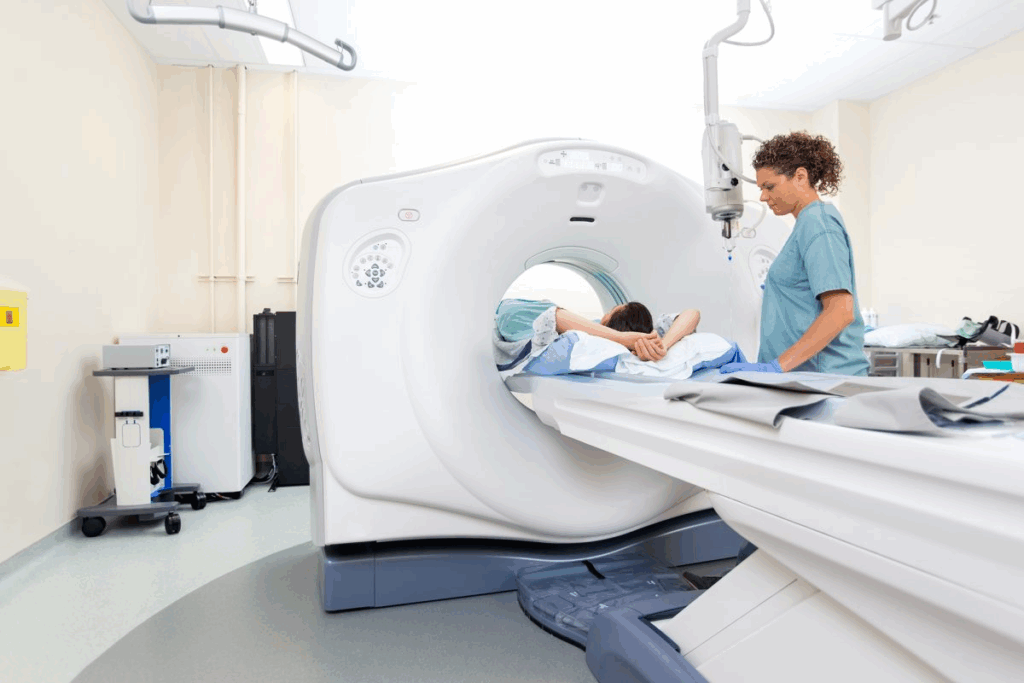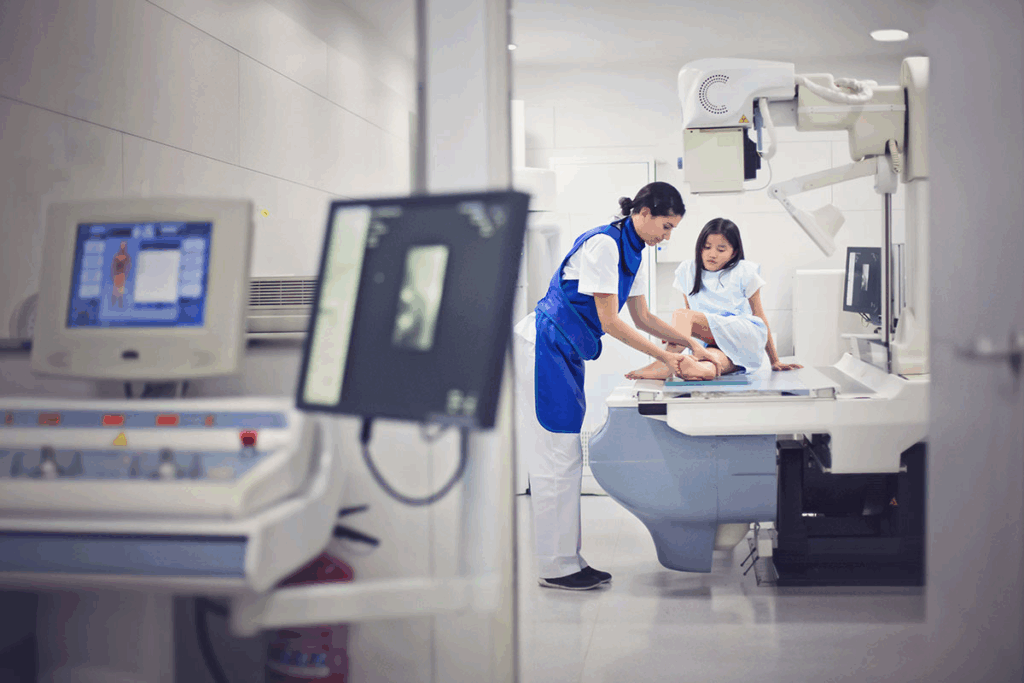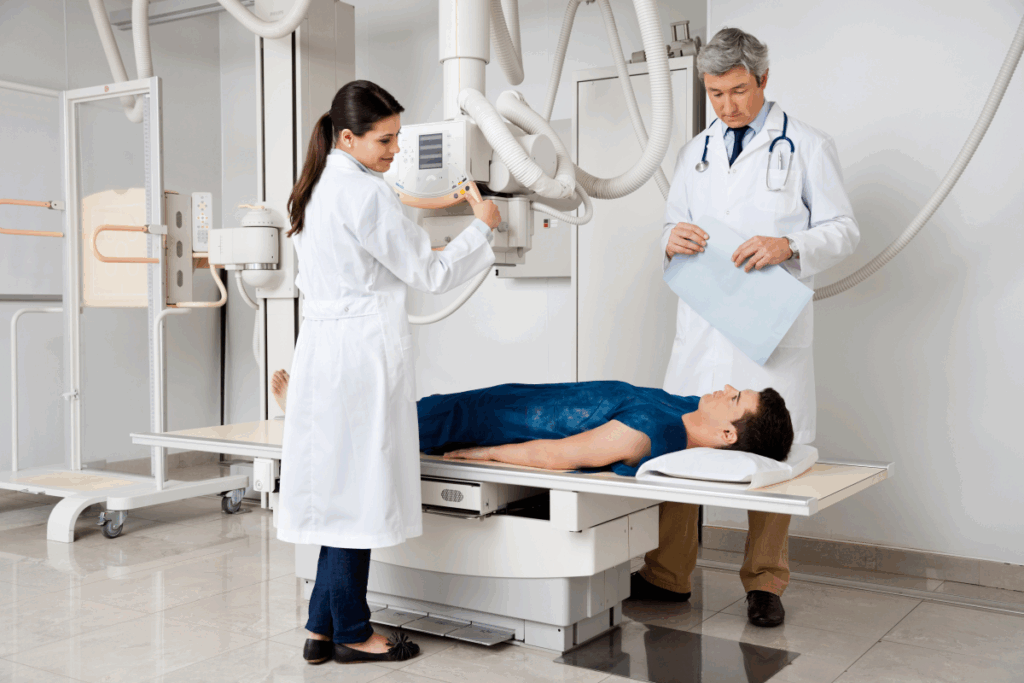Last Updated on October 23, 2025 by mcelik

Medical imaging procedures are key in today’s healthcare. They help doctors make accurate diagnoses and plan treatments. At Liv Hospital, we know how important it is for patients to know about the benefits and risks of these tests. Learn 12 shocking facts about imaging radiation. Our guide covers the risks and safety of common medical imaging procedures.
Every year, about 4.2 billion medical imaging tests are done worldwide. This is according to the United Nations Scientific Committee on the Effects of Atomic Radiation (UNSCEAR) 2020/2021 report. Patients need to understand how radiation imaging helps in their care.
We use the latest technology to keep our patients safe. By knowing the facts about medical imaging radiation, patients can make better choices about their health.

Diagnostic imaging exams are key in today’s medicine. They let doctors see inside the body. These exams are often done, and in many ways, show how vital they are for patient care.
Medical imaging is used more than ever. It’s estimated that 3.6 billion diagnostic imaging exams are done worldwide each year. This shows how important it is for health care.
The number of imaging exams shows how important they are in diagnosing and treating patients. This huge number shows imaging tech is used everywhere in health care.
How often imaging is done varies by age and health condition. For example, older people have more exams because they often have chronic diseases.
Radiography is the most used imaging method, with about 783 exams per 1,000 people. It’s popular because it’s easy to get, not expensive, and works well for many health issues.
Radiography’s big role in imaging shows its value. Doctors trust it a lot for making diagnoses.

Knowing how imaging radiation works is key for both doctors and patients. It helps them make smart choices about tests. Medical imaging is a big part of today’s healthcare.
Medical imaging uses two main types of radiation: ionizing and non-ionizing. Ionizing radiation, like X-rays and gamma rays, can remove electrons from atoms. This is used in many tests, including X-rays and CT scans.
Non-ionizing radiation, like ultrasound and MRI, doesn’t have enough energy to remove electrons. MRI is not traditional radiation, but it’s often talked about with other imaging methods because of its ability to show detailed images.
Ionizing radiation makes images by going through the body. X-rays, for example, pass through soft tissue but are blocked by bone. This contrast helps doctors see inside the body.
In nuclear medicine, tiny amounts of radioactive material are used. These materials emit gamma rays that cameras detect. This helps create images of how the body works.
Doctors measure radiation from tests in different ways. They use the dose area product (DAP), computed tomography dose index (CTDI), and effective dose. The effective dose is in millisieverts (mSv) and considers how different parts of the body react to radiation.
| Modality | Typical Effective Dose (mSv) | Equivalent Background Radiation |
| Chest X-ray | 0.1 | 10 days |
| CT Abdomen/Pelvis | 10 | 3 years |
| Bone Scan | 4.8 | 1.6 years |
Knowing about radiation risks is important for patient safety. Understanding imaging radiation is the first step in making good choices about medical tests.
We use different radiation-based imaging methods to find and treat health issues. These methods are key in today’s healthcare. They give us important info that helps us decide how to treat patients.
X-rays are a common tool in medical imaging. They help us see bones, teeth, and other inside parts. X-rays are great for spotting breaks, finding objects inside the body, and checking the lungs.
The dose from one X-ray is usually low. But it can change based on where in the body it’s taken and the method used.
For example, a chest X-ray has a very low dose. But a CT scan of the belly and pelvis has a much higher dose. Knowing these differences helps doctors and patients make better choices about imaging.
Computed Tomography (CT) scans give detailed images of the body. They’re good for finding tumors, vascular diseases, and internal injuries. CT scans are a big part of medical radiation, making up about 62.6% of it.
New tech like photon-counting CT (PCCT) makes CT scans safer. They give clearer images with less radiation. We use CT scans when we need detailed images for diagnosis and treatment, like in emergency cases.
Nuclear medicine uses tiny amounts of radioactive materials to diagnose and treat diseases. It’s great for seeing how organs and tissues work. Techniques like Positron Emission Tomography (PET) scans help find cancers, brain disorders, and heart diseases.
Nuclear medicine is customized for each condition. It offers both diagnostic and treatment benefits. The radiation from these procedures is managed carefully to ensure the benefits are worth the risks.
Medical imaging uses different amounts of radiation for each procedure. This is important to know the risks and benefits of each imaging method.
Various imaging methods give out different amounts of radiation. For example, a chest X-ray uses about 0.1 millisieverts (mSv). On the other hand, a CT scan of the abdomen and pelvis can expose a patient to around 10 mSv. Here’s a list of common imaging procedures and their radiation doses:
Knowing these doses helps doctors pick the best imaging method for each patient. This way, they can reduce radiation exposure.
It’s useful to compare medical radiation to natural background radiation. The average person gets about 2.4 mSv of background radiation each year. A simple X-ray has a dose similar to a few days of background radiation. But, CT scans can have doses like several years of background radiation.
Getting multiple imaging procedures is a big concern. Studies show over 1% of patients get more than 100 mSv from repeated scans. Children are at higher risk of blood cancers from this radiation. So, it’s key to keep track of each patient’s total radiation dose.
We need to weigh the benefits of imaging against the risks of radiation. This way, we can make sure patients get the info they need without too much radiation.
Medical imaging technology is key to keeping patients safe while getting accurate diagnoses. It’s important to lower radiation exposure as we use these technologies more.
Photon-counting CT (PCCT) is a big step forward in CT scanning. It counts each photon’s energy, unlike old CT scanners. This means better images with less radiation.
PCCT gives clearer images, less noise, and better tissue differentiation. It’s great for those needing many CT scans, as it cuts down radiation over time.
Digital radiography has taken over from film in today’s medicine. It offers lower radiation, quicker images, and better storage and sharing.
| Feature | Digital Radiography | Traditional Film |
| Radiation Exposure | Lower doses possible | Fixed dose required |
| Image Acquisition Time | Instantaneous | Several minutes |
| Image Storage | Electronic, easily accessible | Physical storage required |
Dose optimization software is vital for lowering radiation in imaging. It adjusts settings for patient size, age, and the needed scan.
Some key techniques include:
These tools help doctors reduce radiation while keeping image quality high.
Children are not just small adults. Their bodies are more sensitive to imaging radiation. This means we need special ways to handle medical imaging for kids.
Children’s bodies are more at risk from radiation because their cells are growing fast. They have a longer life ahead, which means any damage from radiation could show up later.
So, we must think carefully about the need for imaging tests in kids. We aim to get the most important information while keeping the radiation dose low.
Studies show that up to 10% of blood cancers in kids might be caused by radiation from medical tests. This highlights the need to use radiation wisely in kids’ care.
By using pediatric-specific protocols, we can cut down on radiation. This might help lower the chance of cancer caused by radiation.
Healthcare teams are creating special plans for kids. They adjust radiation doses based on a child’s size and age. They also try to use other imaging methods when they can.
These steps help us get accurate images while keeping kids safe from too much radiation.
Non-ionizing imaging is safer and reduces radiation exposure. Techniques like ultrasound and MRI are key in our diagnostic tools.
Ultrasound and MRI are leading non-ionizing imaging methods. Ultrasound uses sound waves to see inside the body. It’s great for checking organs and monitoring babies during pregnancy.
MRI (Magnetic Resonance Imaging) uses a magnetic field and radio waves. It’s best for soft tissue images, like the brain and joints.
Choosing non-ionizing imaging depends on the diagnosis needed, patient history, and clinical needs. Pregnant women and kids often get these scans to avoid radiation.
Non-ionizing alternatives are recommended in several situations:
Non-ionizing imaging has many benefits but also some drawbacks. For example, ultrasound might not show as much detail as CT scans for some issues. MRI can’t be used by people with certain implants or pacemakers.
Some main limitations are:
Knowing the pros and cons of non-ionizing imaging helps us make better choices. This improves patient care and safety.
Medical imaging is key in healthcare, but we must weigh its benefits against radiation risks. As we use imaging more for diagnosis and treatment, knowing this balance is vital.
The ALARA principle means keeping radiation exposure as low as possible. It’s about getting the needed diagnostic info without too much radiation. This principle helps ensure patients get imaging benefits while reducing radiation exposure.
Implementing ALARA involves several key strategies:
Healthcare providers must weigh imaging benefits against radiation risks. This is critical for vulnerable groups like children or pregnant women.
The decision to use imaging with ionizing radiation should be based on:
Some groups face higher risks from radiation. Knowing these risks helps make better imaging decisions.
| Population | Risk Factors | Precautions |
| Children | Developing tissues, longer life expectancy | Use pediatric protocols, minimize dose |
| Pregnant Women | Risk to fetus, special risk in early pregnancy | Use alternative imaging when possible, shield the abdomen |
| Young Adults | Longer life expectancy, risk of cumulative dose | Justify each exam, use the lowest necessary dose |
By understanding these risks and taking precautions, healthcare providers can make sure imaging benefits outweigh risks for all patients.
Patient advocacy is key to keeping us safe from radiation in medical imaging. We need to be able to make smart choices about our health care.
It’s important to ask the right questions before any imaging test. We should know why it’s needed, what kind of radiation it uses, and the risks it might pose.
It’s vital to keep a record of our imaging history. This helps us manage our radiation exposure over time.
| Date | Procedure | Radiation Dose |
| 2022-01-01 | CT Scan | 10 mSv |
| 2023-02-01 | X-Ray | 0.1 mSv |
We have the right to know about radiation risks in medical imaging. This includes the dose used and long-term effects.
Key Patient Rights:
Medical imaging is on the verge of a new era. This is thanks to new technologies and a focus on keeping patients safe. These advancements will make diagnosing diseases better and help patients get better faster.
Artificial intelligence (AI) is changing how we use medical imaging. AI can look at lots of data to find the lowest dose needed for clear images. This means patients get less radiation.
Studies show AI can cut radiation doses by up to 50% in some cases. A top radiologist says AI is a game-changer. It makes diagnoses more accurate and cuts down on radiation.
New technologies are also making medical imaging safer and better. For example, compressed sensing and parallel imaging in MRI make scans faster and clearer.
These new tools not only make imaging safer but also help doctors diagnose better. This leads to more accurate treatments for patients.
The future of medical imaging is about tailoring it to each person. Doctors will use data on each patient to create the best imaging plans. This balances getting good images with keeping radiation low.
This is very important for people who are more sensitive to radiation, like kids and pregnant women. They need special care when they have imaging tests.
As we keep improving medical imaging, the future looks bright. With AI, new technologies, and personalized care, we’re moving towards better patient care. This makes medical imaging safer, more effective, and more focused on the patient.
Medical imaging is complex, and making smart choices is key to safety and care. Knowing about imaging radiation and options helps us reduce risks and get the most benefits.
We’ve looked at how common medical imaging is, the types of radiation procedures, and how tech is cutting down on radiation. We’ve also talked about weighing the good of imaging against the risks and the importance of patient safety.
Patients and doctors need to work together to make good choices about imaging. This means understanding radiation doses, knowing the effects of many scans, and picking safer options like ultrasound and MRI when possible.
By staying informed and teaming up, we can make sure imaging is safe and effective. This focuses on getting accurate diagnoses while keeping patients safe. As medical imaging keeps getting better, making smart choices will always be vital for top-notch healthcare.
Medical imaging uses technology to see inside the body. It’s key for diagnosing and treating diseases. It helps doctors plan treatments and track how diseases progress.
Medical imaging is very common, with 3.6 billion exams done worldwide each year. Radiography, or X-rays, is the most used, with 783 exams per 1,000 people.
We use X-rays, gamma rays, and other ionizing radiation in medical imaging. The type of radiation depends on the procedure and the body part being imaged.
We measure radiation exposure with the dose area product (DAP) and effective dose. These metrics help us understand how much radiation a patient gets.
Common procedures include X-rays, CT scans, and nuclear medicine exams. They help diagnose many conditions, from broken bones to cancer.
Radiation doses vary by imaging modality. For example, a chest X-ray has a lower dose than a CT scan. We compare these doses to natural background radiation to understand the risks.
New technologies like photon-counting CT and digital radiography are reducing doses. We’re working to use these technologies to improve safety.
Kids are more sensitive to radiation because their bodies are developing. We use special protocols and safety measures to protect them.
Alternatives include ultrasound and MRI. We use these when possible, for patients at high risk or when benefits outweigh risks.
The ALARA principle aims to minimize radiation exposure while achieving diagnostic goals. We balance the benefits of imaging against the risks of radiation.
Patients can ask questions before imaging, track their imaging history, and know their rights to radiation information. This helps ensure their safety.
Future advancements include artificial intelligence and safer technologies. We aim to use these to improve safety and effectiveness in medical imaging.
References
Subscribe to our e-newsletter to stay informed about the latest innovations in the world of health and exclusive offers!
WhatsApp us